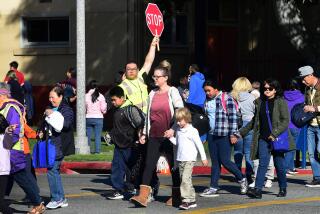Crossing the Line : It’s Time to Get Tough With Repeat Drunk Drivers, an Expert Argues
- Share via
They get behind the wheel with twice the legal limit of alcohol coursing through their systems, and they are 200 times more likely to cause a fatal wreck than the sober driver in the next lane.
Perhaps worse, they know the risks and the consequences but just don’t care.
Hard-core drunk drivers, the repeat offenders who indulge their addictions but ignore the law, may drive under the influence more than 1,000 times before they are caught, according to a new national study by the Century Council, an anti-drunk-driving group funded by leading distillers.
“It’s an overwhelming finding, but we found it was not shocking to police or to the offenders themselves,” said John C. Lawn, chairman of the Los Angeles-based group and former administrator of the Drug Enforcement Administration.
“We found that the hard-core offender drives drunk for years, has heard all the warnings and just ignores them. These are road predators,” he said.
The study was received with mixed feelings by local anti-drunk-driving advocates, who applaud any indictment of repeat DUI offenders but also worry that the distiller-funded study suggests that casual drinkers are a lesser threat.
“If a person at an office party drinks one too many and gets out there and drives, their very same behavior can be as destructive as repeat offenders and big-time drinkers,” said Reidel Post, executive director of the local chapter of Mothers Against Drunk Driving.
“To the person whose family member is killed, it doesn’t matter how impaired the drunk driver was.”
Concerted awareness programs put in place in the early 1980s are credited for greatly reducing the number of alcohol-related deaths and crashes.
In Orange County, for instance, alcohol-related deaths have been reduced by half since 1990 and have not hit triple digits in any year since the 1980s.
Now that the word has spread about the dangers of impaired driving, Lawn said the next front in the battle is to shift the focus to repeat offenders, who defy the law and the odds with a lifestyle of driving drunk.
“To make a big jump now, we have to go after the individuals who drive drunk after they’ve lost their license, after they’ve been through the system, after all the warnings,” he said. “These people are the greatest danger.”
California law defines driving under the influence as having a blood-alcohol level of 0.08% or higher, which for a 180-pound person can likely be reached by drinking four 12-ounce beers in two hours.
A far higher level was often present in fatal crashes nationwide, the study found. Among drivers who were drinking before they died in 1995 crashes, 65% had a blood-alcohol level of 0.15% or greater, the study found.
Overall, these high-level impaired drivers accounted for 27% of drivers who died in all crashes that year.
“These are not casual drinkers,” Lawn said. He added that the study found that drivers with a 0.15% alcohol level account for 1% of the drivers on the road on weekend nights, but they account for 50% of the fatal crashes at that time.
Post and other MADD officials agree that the probability of a crash rises significantly at 0.05% blood-alcohol content and surges dramatically after 0.08%.
But Post also notes that reflex and coordination suffer at levels as low as 0.02%, especially for people who are not accustomed to drinking.
To Anaheim Police Officer Allen W. Eichorn, who racked up 158 DUI arrests last year and more than a 1,000 during his career, the hard-core offenders remain only a fraction of the overall problem.
“With the hard-core drinker, it’s an illness and an attitude. They can’t stay away from the alcohol, and they don’t give a damn who gets in the way,” he said.
“But most of the people I see aren’t that. I see people who drink one or two drinks and think they’re just fine. They drink and drive because it’s still socially acceptable. And it’s the holidays.”
More to Read
Sign up for Essential California
The most important California stories and recommendations in your inbox every morning.
You may occasionally receive promotional content from the Los Angeles Times.













